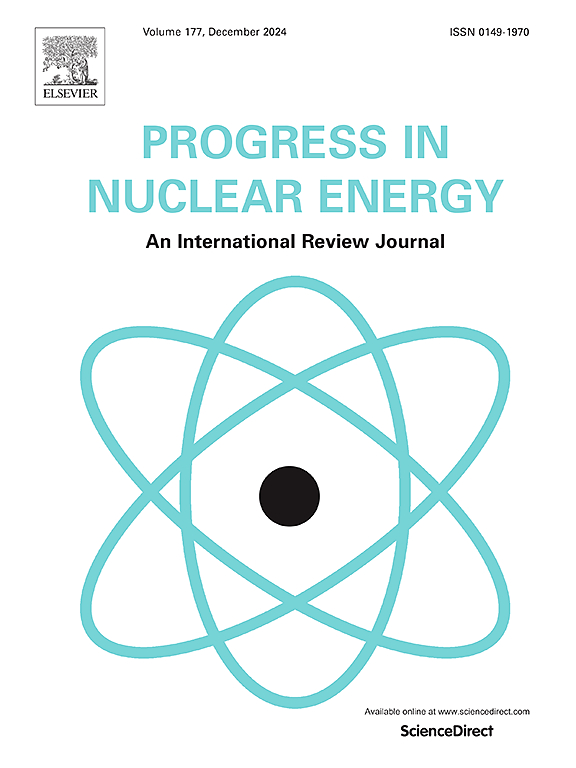熔盐核反应堆中熔盐和He-CO2工况下螺旋盘管换热器性能的数值分析
IF 3.2
3区 工程技术
Q1 NUCLEAR SCIENCE & TECHNOLOGY
引用次数: 0
摘要
除了日益增长的全球能源需求外,常规可再生能源的间歇性也日益引起人们对核能的关注。本文以熔盐堆(MSR)中负责冷却液循环的换热器为研究对象,对螺旋盘管换热器进行数值分析。数值模拟采用计算流体动力学(CFD)方法进行,并使用ANSYS Fluent®软件完成。最初,对纯二氧化碳气体进行了分析。随后,将CO2与25%、50%和75%的氦气(He)混合,并对每种情况进行分析。最后对纯He性能进行评价。每组分析在雷诺数(Re)为50000和100000时进行。结果表明,Re数的增加显著提高了换热速率。氦气的加入显著提高了传热速率,其中纯氦气的传热速率最大。然而,氦气的运输和成本也必须考虑在内。最终,在当前模型中,将CO2与He混合可以显著改善系统性能,并可能直接影响核反应堆的功率输出。这种方法可以实现更高的冷却液温度,从而促进更高的能量转换效率。本文章由计算机程序翻译,如有差异,请以英文原文为准。
Numerical analysis of a helically coiled tube heat exchanger performance utilized in molten salt nuclear reactors for molten salt and He-CO2 working fluid conditions
In addition to the growing global energy demand, the intermittency of conventional renewable energy sources has increasingly directed attention toward nuclear energy. In this study, a heat exchanger responsible for circulating the coolant fluids in Molten Salt Reactors (MSR) was investigated, and the numerical analysis of a helically coiled tube heat exchanger was carried out. The numerical simulations were performed using the Computational Fluid Dynamics (CFD) approach and completed with ANSYS Fluent® software. Initially, analyses were conducted for pure CO2 gas. Subsequently, CO2 was mixed with 25 %, 50 %, and 75 % helium (He) gas, and analyses were completed for each case. Finally, pure He performance was evaluated. Each set of analyses was performed for Reynolds numbers (Re) of 50000 and 100000. The results indicate that an increase in the Re number significantly enhanced the heat transfer rate. The addition of helium notably increased the heat transfer rate, with the maximum rate being obtained using pure He gas. However, the transportation and cost of helium must also be considered. Ultimately, mixing CO2 with He in the current model significantly improved system performance and could directly impact the power output of nuclear reactors. This approach enables higher coolant fluid temperatures to be achieved, thereby facilitating greater energy conversion efficiency.
求助全文
通过发布文献求助,成功后即可免费获取论文全文。
去求助
来源期刊

Progress in Nuclear Energy
工程技术-核科学技术
CiteScore
5.30
自引率
14.80%
发文量
331
审稿时长
3.5 months
期刊介绍:
Progress in Nuclear Energy is an international review journal covering all aspects of nuclear science and engineering. In keeping with the maturity of nuclear power, articles on safety, siting and environmental problems are encouraged, as are those associated with economics and fuel management. However, basic physics and engineering will remain an important aspect of the editorial policy. Articles published are either of a review nature or present new material in more depth. They are aimed at researchers and technically-oriented managers working in the nuclear energy field.
Please note the following:
1) PNE seeks high quality research papers which are medium to long in length. Short research papers should be submitted to the journal Annals in Nuclear Energy.
2) PNE reserves the right to reject papers which are based solely on routine application of computer codes used to produce reactor designs or explain existing reactor phenomena. Such papers, although worthy, are best left as laboratory reports whereas Progress in Nuclear Energy seeks papers of originality, which are archival in nature, in the fields of mathematical and experimental nuclear technology, including fission, fusion (blanket physics, radiation damage), safety, materials aspects, economics, etc.
3) Review papers, which may occasionally be invited, are particularly sought by the journal in these fields.
 求助内容:
求助内容: 应助结果提醒方式:
应助结果提醒方式:


